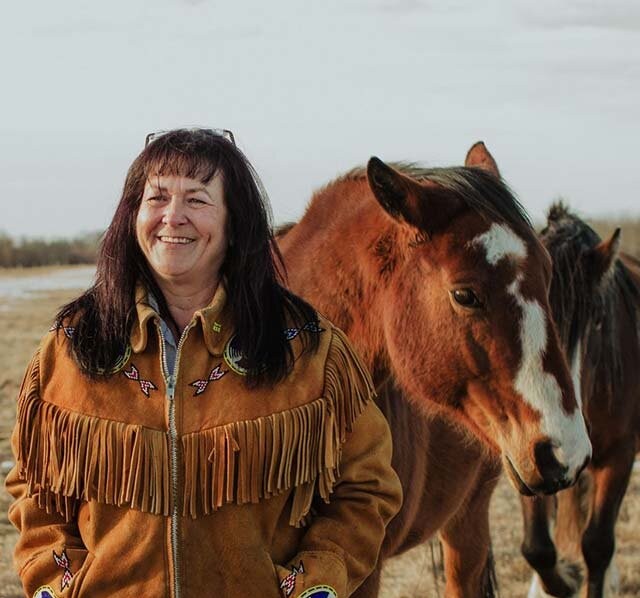There are several avenues to determine Métis ancestry in the province says the president of one organization.
Charlene Lavallee is the president of AMNSIS (Association of Métis Non and Status Indians Saskatchewan), an organization working for non-status Indian, Métis, and Inuit people in the province “regardless of where you grew up or your membership with other organizations.”
In an interview with MBC News this week, Lavallee took issue to a statement issued recently by the Métis Nation-Saskatchewan, which stated “In Saskatchewan, determining ‘Who is a Métis citizen?’ is the sole determination of the Métis Nation-Saskatchewan and no one else.”
“It’s a membership, that’s what it is,” said Lavallee when referring to the MN-S registration system.
The statement from the Métis Nation-Saskatchewan came in response to a CBC article calling into question the Indigenous ancestry claims of U of S researcher Carrie Bourassa who claimed to be Métis, Tlingit and Anishinaabe. In response to the article, Bourassa released a statement that claimed her Métis heritage had been vetted by the Regina Riel Métis Council. The council has not yet made any sort of public statement on Bourassa’s claims and has not responded to an MBC News request for comment. However, Bourassa still had no evidence to back up her claims of Tlingit and Anishinaabe heritage.
In the wake of the article, Bourassa was placed on leave from the U of S and removed from other positions as well.
The story has raised questions for some on what and who has the authority to determine someone as Métis. In an interview with MBC News earlier this week U of S professor Ken Coates says the answer to this question is very complicated, but it is an important one moving forward.
Coates had high praise for the MN-S registration system and called it “open” and “inclusive.”
For Charlene Lavallee and AMNSIS, however, there are many more Métis people in the province who are not under the MN-S and their rights shouldn’t be excluded.
In Saskatchewan, around 80,000 people identify as Métis, however, only around 25,000 are currently registered or undergoing the registration process with the MN-S.
Lavallee is a Métis person with roots in the Batoche area. While she is very proud of her heritage she is no longer a member of the MN-S.
“I was not going to surrender my sovereign right to an organization,” said Lavallee. “I am not signing that right over to anybody and that’s why I left and that’s why many people left.”
Lavallee says AMNSIS is in the process of developing a process of their own to help Métis people in the province, not under the MN-S, determine their heritage. She says they have the plans laid out, they are just waiting for approval from their AGA and for some federal funding.
MN-S call to post-secondary institutions
Recently, the Métis Nation-Saskatchewan has also made a push to have post-secondary institutions stop relying on self-identification and to adopt its definition of Métis citizenship when hiring people and giving out scholarships.
While Lavallee agrees that self-identification is not enough she is concerned about one organization determining who is or isn’t Métis on this level.
“It’s not as simple as saying you have to have a certain card,” said Lavallee. “You don’t have to have a card, you can get verification from your community.”
Lavallee is concerned if universities adopt an MN-S requirement to determine Métis lineage as she believes it may go against an individual’s Charter rights to association. Lavallee does acknowledge the public needs to be confident these organizations are vetting properly and that’s why she says AMNSIS is working hard to develop its vetting process as well.
“We are hoping to bring it all in line, so it is consistent across the province,” said Lavallee.
Debate on Métis lineage on the national level
In recent months, the public has also seen this debate on a national scale with the Manitoba Métis Federation leaving the Métis National Council over concerns of Métis identity. The MMF asserts to be Métis a person must have historic ties to the Red River Métis in Manitoba.
“There is a lot more to it than the MMF is making it out to be,” said Lavallee. “Who am I from Batoche, Saskatchewan to say someone in Gatineau, Quebec is Métis or not. There are as many different Mĕtis communities and different Métis groups as there are Cree.”
For Lavallee, she believes it is up to each individual Métis group and organization to determine those they represent as Métis individuals. However, she says these communities need to do their work to make sure they are accountable and “beyond dispute.”
As the questions and debates continue around who and what makes a person Métis, Lavallee is hoping groups and organizations can move beyond the infighting.
“We just need a respectful discussion,” she said.
(PHOTO: Charlene Lavallee, provided by AMNSIS.)
